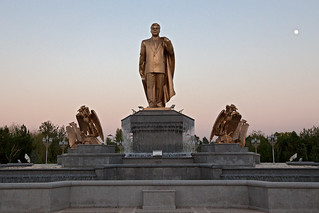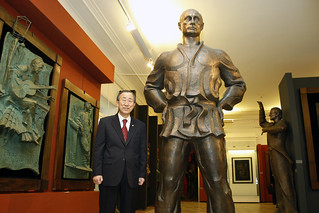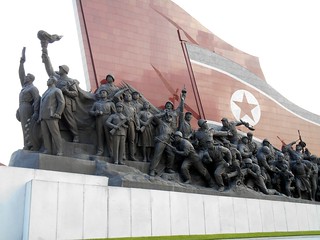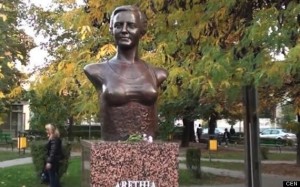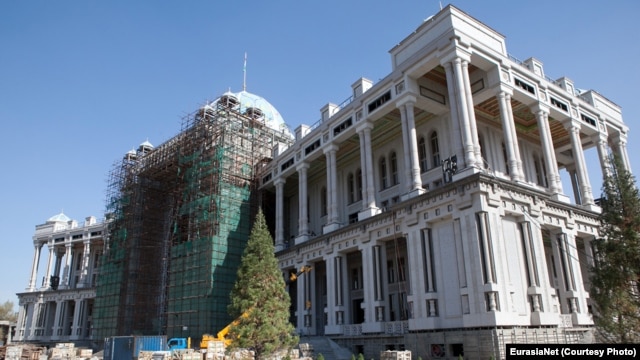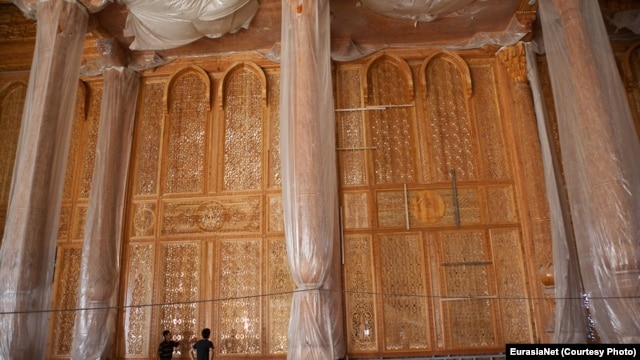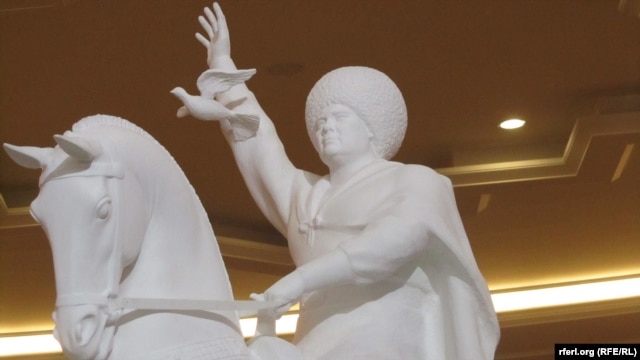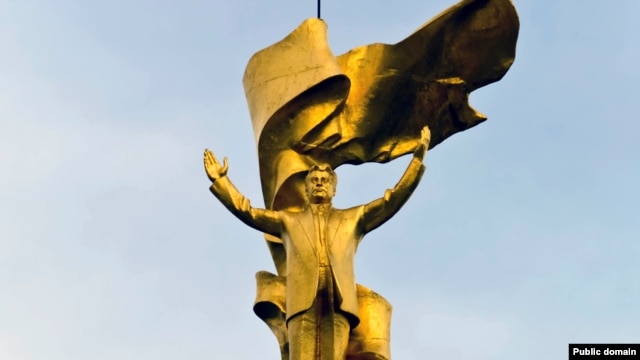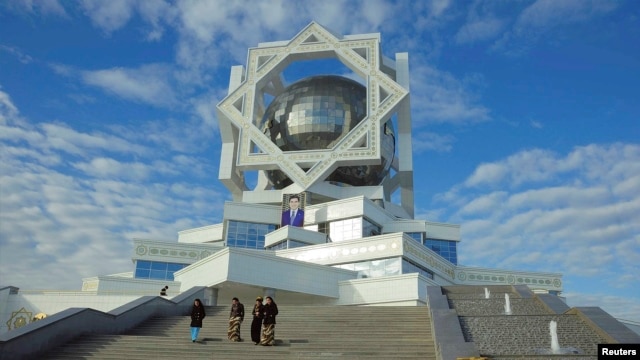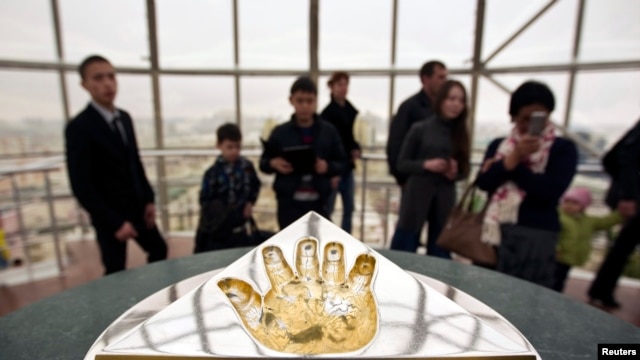-
Post-Communist Monuments to Women
- July 23, 2018 - 2:40 pm
- New monument, Women
- Comments Off on Post-Communist Monuments to Women
by Isabel Post
ARIA Undergraduate Researcher at McGill University
Where are the monuments to women in the post-Communist world, and what do they look like? Are women better represented in this space than outside of it? How have monuments to women or depicting women fared since the collapse of communism? To answer these questions, I coded the Post-Communist Monuments Project’s database of alterations to post-Communist monuments between 1984 and 2009, as well as used some informal data from Google Images search results, to shed light on the prevalence and content of monuments to women in the post-Communist world.
The database I initially used to measure representation of women documents action associated with monuments by collecting and quantifying media representation of the events, incidents, and discussions that surround them. Therefore, the examples that came to light in this initial research can only indicate monuments to women that are subjected to action, rather than the vast population of monuments to women that simply exists but does not make headlines. However, monuments to women that undergo action are somewhat representative of the larger body of monuments to women, therefore allowing the possibility for broader conclusions to be drawn from their analysis.
The most straightforward finding of the database analysis was that monuments to women make up a miniscule percentage of the total monuments that made headlines during between 1989 and 2009. Of the 2036 monuments used in the analysis, women were the focus or primary content of only 50, roughly 2.4 percent, or one out of every 41 monuments. While it doesn’t come as much of a surprise that women are grossly underrepresented in monuments, this figure is much lower than I had originally expected. That said, the figure does not account for depictions of women as part of larger groups in statues in which they are not the primary focus of the monument’s content, which may deflate the statistic. The rarity of monuments to women is in the post-Communist world is significant, but unlikely to be an anomaly. Rather, I theorize that it’s only a semi-localized example of a ubiquitous dearth of such monuments in the world.
I had also hypothesized that women would be primarily represented as ideological symbols: for example, a kolkhoznitsa or Mother Homeland. This theory was prompted by an prior informal study using Google Images which indicated that in western countries, women were more often portrayed in monuments as ideological symbols than as individuals. Initially, this appeared not to be the case-- in the post-Communist world; 25 (50 %) of monuments to women documented were dedicated to individual women, or 1.4 percent of the entire database. However, this disparity is likely to have resulted from the two types of data collection: google image search versus news article collection. To clarify, I followed up with a google image search on 10 post-Communist countries (Albania, Ukraine, Russia, Kyrgyzstan, Mongolia, Serbia, Romania, Hungary, Estonia, and Georgia) and found that the prevalence of monuments to individual women was not in fact greater than in the non-post-Communist world. So, while we can say that the majority of “newsworthy” post-Communist monuments to women memorialize monuments to individual women, this is not a constant across monuments in this space, and can’t be logically compared to the prevalence of monuments to women outside the space.
On a related note, interestingly enough, the Google Images search returned more monuments to symbolic women than the search done on monuments in Britain (5% versus 2.4% respectively). Because counting results on Google Images for “(country name) monument) is hardly an exact science, this could be meaningless, but does warrant further investigation.
Going back to the database search, the different categories of women portrayed also proved significant and contradicted my expectations. Overall, the monuments to individual women that received news coverage 1984-2009 most commonly memorialized female political figures. This figure stands at 11 monuments, or 42%. While I had hypothesized that most individual women commemorated would be memorialized for their achievements in non-political spheres, such as art, poetry, or dance, this this was also not the case. Of the 25 monuments in the database to individual women, only 6, or 24%, were to women in the arts. This figure consists of three poets, one actress, one dancer, and one singer. Next, another six monuments (24%) memorialized women as individuals for their accomplishments outside the realm of politics or the arts-- for example, women such as pioneer aviator Valentina Grizodubova or famous Communist partisan Zoya Kosmodemyanskaya. Finally, three of the monuments (12%) memorialize women for their connection to a famous man; these monuments are to the mother of Yuri Gagarin, the first wife of Genghis Khan, and the Virgin Mary.
Why are most of these women political figures? Initially I posited that this could be caused by a uniquely substantive inclusion of women in politics in communist regimes compared with the rest of the world. Generally, women were better represented in politics in communist regimes than outside of them[1]. However, further coding showed that only 27 percent of monuments to political women referred to women in politics under communism (to Zoya Kosmodemyanskaya, Milada Horakova, and Galina Starovoitova). More significantly, 54 percent of monuments to political women referred to the pre-Communist period (three of which are to Catherine the Great, with the other three featuring Kurmanjan Datka of Kyrgyzstan and Rosa Luxemburg, and the executed Romanov women), and the remaining 18 percent to the post-Communist period (Yulia Tymoshenko and Anna Lindh). Therefore, although this could speak to a disparity in the mechanisms by which women could become accomplished under communist regimes (through politics) versus outside of it, this is unlikely given the distribution of these women across their respective time periods. Another interesting finding was that 100 percent of the monuments to female artists were of a woman who made her career during or were built during her country’s Communist period. This may indicate that Communism actually made it easier for women to be memorialized as artists than as politicians. However, additional research on the memorialization of female artists globally is necessary to confirm that this phenomenon is specific at all to the post-Communist world rather than simply the product of a common era.
Comparatively, New York City’s central park contains 23 monuments to individual male historical figures, but not a single depiction of an individual woman[2]. Similarly, an informal study on monuments in the UK found that 28 percent of monuments to women were to individual women in history (who are not the Virgin Mary)[3], compared to 50 percent of “newsworthy” monuments in the post-Communist world (both of these statistics include royal women, who in both cases account for approximately half of the historical women). So, are women actually better represented as individuals in monuments of the post-Communist world? Realistically, this doesn’t seem to be the case, as the database findings that suggested women were better represented in the postcommunist world were contradicted by the Google Images data. The reason for the disparity in findings could be is likely that the database catalogues only monuments deemed “newsworthy”, while Google Images tends to give search results that are more static, from travel websites and Wikipedia articles. In the absence of congruent databases, it’s not possible to say whether women are truly represented better in one context versus the other. However, it is possible to say that overall, there is a comparable dearth of monuments featuring women-- either as individuals or as symbols-- in both the post-Communist world and the space outside of it.
[1] Elin Bjarnegård & Erik Melander (2013) Revisiting Representation: Communism, Women in Politics, and the Decline of Armed Conflict in East Asia, International Interactions, 39:4, 558-574,DOI: 10.1080/03050629.2013.805132
[2] https://www.citylab.com/design/2016/02/the-gender-gap-in-public-sculpture/463170/
[3] https://www.newstatesman.com/politics/feminism/2016/03/i-sorted-uk-s-statues-gender-mere-27-cent-are-historical-non-royal-women
-
I-Phone Missing
- May 28, 2015 - 11:46 pm
- New monument, Russia
- Comments Off on I-Phone Missing
By Maryna Polataiko for postcommunistmonuments.ca
Photo: Steve Jobs and Dmitry Medvedev
Following the death of former Apple CEO Steve Jobs, a monument in his memory was set up on the campus of an IT institute in St. Petersburg (Russia). Resourced by domestic company Western European Financial Union (WEFU), the Jobs monument consisted of an oversized iPhone whose touch screen the public could interact with.
However, when Tom Cook—Apple’s successive CEO—came out as gay in a public essay, the larger-than-life electronic device was taken down. Some Russian media reported that the fixture was simply under repair. But allegedly, the monument was taken down in order to comply with Russia’s infamous anti-gay ‘propaganda’ laws. Nonetheless, observers speculate that the removal could not solely be traced back to bigotry.
Writing for Fortune magazine, Philip Elmer DeWitt reports that President of WEFU Maksim Dolgopolov also cited supposed links between Apple and the NSA as a reason behind the iPhone’s confiscation. More broadly, Adam Chandler at The Atlantic suggests that this was an act of defiance against the presence of American symbols in Russia.
In any case, the Russian Holdings Company put the exiled monument up for sale—with US $ 95,000 as the asking price!
[SOURCES:]
Adam Chandler. “Why Russia Really Tore Down Its Jobs Memorial.” The Atlantic, November 3, 2014. Accessed November 29, 2014. http://www.theatlantic.com/international/archive/2014/11/steve-jobs-memorial-torn-down-after-tim-cook-comes-out/382319/.
http://fortune.com/2014/11/03/why-the-steve-jobs-memorial-in-st-petersburg-was-removed/
Philip Elmer-DeWitt. “Why Steve Jobs Memorial in St. Petersburg was Removed.” Fortune, November 3, 2014. Accessed November 29, 2014. http://fortune.com/2014/11/03/why-the-steve-jobs-memorial-in-st-petersburg-was-removed/.
http://www.rferl.org/content/russia-st-petersburg-monument-iphone-jobs-cook-gay/26671992.html
“Monument To Apple’s Jobs Removed in Russian After CEO Comes Out.” Radio Free Europe, November 3, 2014. Accessed November 29, 2014. http://www.rferl.org/content/russia-st-petersburg-monument-iphone-jobs-cook-gay/26671992.html.
http://www.engadget.com/2014/12/02/buy-the-steve-jobs-monument-that-was-too-gay-for-russia-for-95/
Mike Wehner. “Buy the Steve Jobs Monument that was Too Gay for Russia for $ 95,000.” Engaget, December 2, 2015. Accessed January 15, 2015. http://www.engadget.com/2014/12/02/buy-the-steve-jobs-monument-that-was-too-gay-for-russia-for-95/.
-
Poland's "Fountain of the Future"
- May 28, 2015 - 11:42 pm
- Lenin, New monument, Poland
- Comments Off on Poland's "Fountain of the Future"
By Maryna Polataiko for postcommunistmonuments.ca
Right now, many post-Soviet states are in the midst of a sculptural demolition derby. Numerous countries are trying to wipe communism from their public spaces by removing monuments of a bygone era. And while Poland is certainly participating in this trend—think the ‘Four Sleepers’ debacle in Warsaw—artists near Krakow have put their own spin on distancing themselves from Russia.
As part of the Grolsch ArtBoom Festival in Krakow, artists Małgorzata Szydłowska and Bartosz Szydłowsk produced a little, bright yellow Lenin. Standing where a Soviet-era Lenin once was (and was removed in 1989), the miniature’s fountain water doubles as a urine stream.
While the ‘Fountain of the Future’ is meant to be temporary—stimulating discussion on what should really be taking its place—a permanent residence for the peeing figure would not be so bad either.
[SOURCES:]
http://time.com/2867197/polish-city-erects-statue-of-peeing-lenin/
Denver Nicks. “Polish City Erects Statue of Peeing Lenin.” Time, June 12, 2014. Accessed June 22, 2015. http://time.com/2867197/polish-city-erects-statue-of-peeing-lenin/.
http://www.artslant.com/la/articles/show/39841
Max Nesterak. “Krakow Erects A Bright Yellow Statue of Lenin Peeing.” ArtSlant Los Angeles, June 13, 2014. Accessed June 22, 2015. http://www.artslant.com/la/articles/show/39841.
http://www.artboomfestival.pl/en/4/2/10361
“Big Boom in Nova Huta.” Grolsch Artboom Festival in Krakow, June 9, 2014. Accessed June 22, 2015. http://www.artboomfestival.pl/en/4/2/10361.
-
Dental Gold: Arkadag's Very Own Monument
- May 28, 2015 - 11:40 pm
- New monument, Turkmenistan
- Comments Off on Dental Gold: Arkadag's Very Own Monument
By Maryna Polataiko for postcommunistmonuments.ca
If you are at all familiar with Turkmenistan’s recent history, then you have likely been acquainted with its grandiose (and often golden) monuments. Their origin can be traced back to the late Saparmurat Atayevich Niyazov—or Turkmenbashi—President of Turkmenistan between 1985 and 2006, when he passed away. Gargantuan in size, these monuments served to reinforce Niyazov’s infamous cult of personality. Sculptures of him dominate the nation’s landscape to this day.
However, Niyazov’s successor (and former dentist) President Gurbanguly Berdymukhammedov—also known as Arkadag—seems ready to take over some of Turkmenistan’s public space. In July 2014 it was announced that—in response to alleged public demand—a new monument to Berdymukhammedov is in the cards. Arrangements for a 5-meter likeness of the President riding his horse had been made by sculptor Saragt Babaev,
[SOURCES:]
http://www.chrono-tm.org/en/2014/07/the-first-monument-to-turkmenistans-second-president/
“The First Monument to Turkmenistan’s Second President.” Chronicles of Turkmenistan, July 30, 2014. Accessed September 15, 2015. http://www.chrono-tm.org/en/2014/07/the-first-monument-to-turkmenistans-second-president/.
http://www.rferl.org/content/turkmenistan-statue-berdymukhammedov/25473028.html
Qishloq Ovozi. “Here We Go Again: Turkmen Statue Proposal Suggests History May Be Repeating Itself.” Radio Free Europe, July 28, 2014. Accesses August 21, 2014. http://www.rferl.org/content/turkmenistan-statue-berdymukhammedov/25473028.html.
Ella Morton. “Golden Statue and Mother Bread: The Bizarre Legacy of Turkmenistan’s Former Dictator.” Atlas Obscura, February 6, 2014. Accessed February 20, 2014. http://www.slate.com/blogs/atlas_obscura/2014/02/06/saparmurat_niyazov_former_president_of_turkmenistan_has_left_quite_the_legacy.html.
-
Putin the Emperor?
- May 28, 2015 - 11:35 pm
- New monument, Putin, Russia, WWII
- Comments Off on Putin the Emperor?
By Maryna Polataiko for postcommunistmonuments.ca
Adorned with laurels, armor and a toga, a new Roman-emperor-style bust of Russian President Vladimir Putin has entered into the world. The initiative to erect the bronze-cast Putin was spearheaded by St. Petersburg Cossacks, with sculptor Pavel Greshnikov creating the likeness of the ruler. The idea to commemorate Putin came in the wake of Russia’s annexation of Eastern Ukraine, which Ataman of the St. Petersburg Cossacks Andrei Polyakov says is bringing the Russian empire back together again.
This is not the first sculpture of Putin clad in curious attire. Pictured is UN Secretary-General Ban Ki-moon posing with a grandiose monument to Putin at the Tsereteli Gallery in Moscow. Naturally, the Russian President is wearing Judo gear.
Putin’s bust will be revealed on May 9, 2015 (‘Victory Day’) at a metro station at the edge of St. Petersburg, the emperor’s hometown.
[SOURCES:]
http://www.rferl.org/content/cossacks-putin-statue-as-roman-emporer/26909584.html
“Cossacks Plan Victory Day Bust of Putin As Roman Emperor.” Radio Free Europe, March 19, 2015. Accessed March 23, 2015. http://www.rferl.org/content/cossacks-putin-statue-as-roman-emporer/26909584.html.
http://www.mirror.co.uk/news/world-news/vladimir-putin-depicted-roman-emperor-5385828
Dominic Smith. “Vladimir Putin to be Depicted as Roman Emperor in Statue Built in His Hometown.” Mirror, March 23, 2015. Accessed March 23, 2015. http://www.mirror.co.uk/news/world-news/vladimir-putin-depicted-roman-emperor-5385828.
“Russian Academy of Arts and Zurab Tsereteli Gallery. RusMania. Accessed March 23, 2015. http://rusmania.com/central/moscow-federal-city/moscow/khamovniki/?s=russian-academy-of-arts-and-zurab-tsereteli-gallery.
-
The Museum of Maidan
- May 28, 2015 - 11:21 pm
- New monument, Ukraine
- Comments Off on The Museum of Maidan
By Maryna Polataiko for postcommunistmonuments.ca
Last year, the Kyiv City State Administration and Ukraine’s Ministry of Culture kicked off a competition asking Ukrainians to design a memorial commemorating the Heavenly Hundred Heroes—those who died at the Maidan Nezalezhnosti. Today, the competition for the project, “Terra Dignitas: Reinventing Public Space in Kyiv’s City Core and Commemorating the Revolution of Dignity,” is soliciting proposals for the entire surrounding space, worldwide.
Competition on the best project/design of the “Museum of Maidan” ignited a robust discussion in social networks. There are 24 submissions in this category, with 148 project proposals all in all—with ideas ranging from an “angel with a cross to light art installation”—competing in 4 categories. The remaining categories concern the design of the space of Maidan and Kyiv`s city core (with 29 competing projects), the commemoration the Revolution of Dignity and memory of the Heavenly Hundred Heroes (boasting a whopping 86 proposed projects), and the International cultural center "Ukrainian House on European Square" (9 projects).
Public discussion and polling will continue until the beginning of May, and then the results will be given to a professional jury.
In recent discussions, it has been agreed that the renovation of the Maidan into a beautiful and inviting public space—including benches, fountains, and playgrounds—should take priority over museums and monuments. University Lecturer Vladyslava Osmak suggests that the area ought to be a place of celebration and healing rather than a place of mourning.
There will be a “memory lane” and a museum to commemorate the Heavenly Hundred, but Osmak asserted: “not a Soviet-style monument.”
[SOURCES:]
http://terradignitas.kga.gov.ua/en/
Міжнародний відкритий конкурс «Територія гідності»/International Open competition “Terra Dignitas.” Accessed December 15, 2014. http://terradignitas.kga.gov.ua/en/.
Rory Stott. “City of Kyiv Launches ‘Terra Dignitas’ Revolution Memorial Competition.” ArchDaily, November 1, 2014. Accessed November 15, 2014. http://terradignitas.kga.gov.ua/en/.
http://mignews.com.ua/regiony/kiev/5308128.html
http://news.yahoo.com/museum-memory-lane-kiev-mulls-memorial-maidan-victims-191145241.html
Claire Rosemberg and Olga Shylenko. “Museum or Memory Lane? Kiev Mulls Memorial to Maidan Victims.” Yahoo News, April 17, 2015. Accessed April 18, 2015. http://news.yahoo.com/museum-memory-lane-kiev-mulls-memorial-maidan-victims-191145241.html.
«До створення пам'ятного меморіалу Героям Небесної Сотні приєднаються міжнародні митці.» дивись.inf, November 14, 2014. Accessed December 5, 2014. http://dyvys.info/kultura/do-stvorennya-pam-yatnoho-memorialu-heroyam-nebesnoji-sotni-pryjednayutsya-mizhnarodni-myttsi-foto.html.
«Від янгола з хрестом до світової інсталяції: яким стане Майдан.» MEDIEMIX. TV 24, April 7, 2015. Accessed April 25, 2015. http://www.mediemix.com.ua/detail/196996-Від-янгола-з-хрестом-до-світової-інсталяції-яким-стане-Майдан.
-
Socialist Realism Across the Globe!
- May 28, 2015 - 11:14 pm
- New monument, North Korea, Senegal
- Comments Off on Socialist Realism Across the Globe!
By Maryna Polataiko for postcommunistmonuments.ca
Monuments in Africa, made in North Korea, inspired by the Soviet Union!
Commissioned by Senegal, Pyongyang’s Mansudae Overseas Projects is responsible for the 160-foot African Renaissance Monument erected in 2006. Operated by the North Korean government, Mansudae’s factory specializes in the production of gargantuan—yet fairly inexpensive—monuments largely inspired by a Soviet aesthetic.
Purportedly embodying the end of Senegal’s colonial history, the statue was ordered by former president Abdoulaye Wade. Mansudae’s sculptures brandish the earmarks of Socialist realism, depicting sharp figures, larger than life and imbued with state ideology. This Soviet motif, however, is not limited to the outskirts of Dakar.
Senegal is among 18 other states that are home to Mansudae monuments. The majority of countries outsourcing to the Pyongyang-based company find themselves in Africa and Asia. Apparently, the legacy of the U.S.S.R.’s aesthetic regime crosses continental boundaries.
From top to bottom: African Renaissance Monument, two other Mansudae monuments
[SOURCES:]
Sarah Cascone. “The North Korean Art Factory Cranking Out Soviet-Style Monuments.” ArtNet, August 5, 2014. Accessed September 5, 2014. https://news.artnet.com/art-world/the-north-korean-art-factory-cranking-out-soviet-style-monuments-73226.
Ella Morton. “The Controversial Senegalese Monument Built by North Korean Propaganda Artists.” Atlas Obscura, August 4, 2014. Accessed September 30, 2014. http://www.slate.com/blogs/atlas_obscura/2014/08/04/the_african_renaissance_monument_in_dakar_senegal.html.
http://artcocktail.mallforarts.com/2014/12/the-north-korean-monuments-in-africa/
Victor. “The North Korean Monuments in Africa.” Art Cocktail, December 1, 2014. Accessed December 10, 2014. http://artcocktail.mallforarts.com/2014/12/the-north-korean-monuments-in-africa/.
-
Poland Pays Tribute to Wikipedia
- May 28, 2015 - 10:54 pm
- New monument, Poland
- Comments Off on Poland Pays Tribute to Wikipedia
By Maryna Polataiko for postcommunistmonuments.ca
In October 2015, a monument to information-sharing site Wikipedia was erected in Slubice, Poland. Director of Collegium Poloncium—a university located in Slubice— Krzysztof Wojciechowski came up with the idea to construct it. The $14,000, 2-meter brass-like version of Wikipedia’s logo is held up by four human figures, honouring the Wiki community, whose work is integral to the website’s widespread dissemination of knowledge.
The small-town attraction accurately represent’s Poland’s enthusiasm and involvement with the website. The country’s Wikipedia page contains over a million articles, ranking it the 12th largest Wiki site in the world.
Sources:
https://news.artnet.com/in-brief/wikipedia-gets-a-monumentin-poland-131107
Neuendorf, Henri. 'Wikipedia Gets A Monument... In Poland - Artnet News'. artnet News, October 16, 2014. Accessed May 4, 2015. https://news.artnet.com/in-brief/wikipedia-gets-a-monumentin-poland-131107.
-
A Tale of Two Romanian Monuments
- April 21, 2014 - 10:22 pm
- New monument, Romania
- Comments Off on A Tale of Two Romanian Monuments
From the Huffington Post - - -
Celebrating a Magnificent War Memorial on the International Day for Monuments and Sites
President, World Monuments Fund
Posted: 04/17/2014 6:26 pm EDT Updated: 04/17/2014 6:59 pm EDT
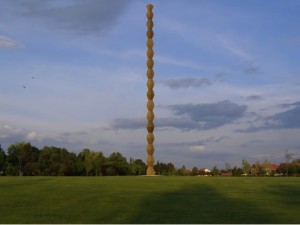
©Mike Masters Attribution-ShareAlike 3.0 Romania (CC BY-SA 3.0 RO) (Creative Commons)April 18 is the International Day for Monuments and Sites, a day when we remember and celebrate the places that mean the most to us. This year's theme is commemorative monuments. Many of our monuments were built to commemorate an event or to memorialize the builder. From the pyramids at Giza to statues of Stalin and Lenin, these monuments can have very charged political meanings within a moment in time, but also tend to take on new meanings as time passes. Today we may value these places for reasons that have nothing to do with why they were built.
An astonishing commemorative monument in this context is Brancusi's Endless Column ensemble in the small town of Târgu Jiu, Romania, which is today hailed as one of the greatest works of twentieth-century public art. The sculptural ensemble was born as the commission of a sculpture by the National League of Gorj Women. They had in mind a classic World War I commemoration of the decisive battle for Romanian independence that was fought in the town, defending a bridge across the River Jiu. Originally they offered the commission to a local sculptor, Militsa Petrascu, who had recently completed another commemorative work in the town. With remarkable candor, he told them he was not up to the task, and suggested Brancusi. We can only thank him for this act of modesty.
Brancusi was living in Paris, but had been born and raised in the nearby town of Hobita. He promptly accepted the commission. It gave him an opportunity to execute on a large scale a theme that he had worked with over many years -- the "endless column." Brancusi carved several endless columns in wood starting in 1917. The earliest of them is in the Museum of Modern Art in New York, and others can be found in his studio, now conserved as it was left when he died in the Pompidou Center in Paris. The columns were based on a local style of house post in Romania, which Brancusi transformed into an enigmatic and spiritual symbol, brimming with energy. Brancusi described the form as "art imitating nature."
Brancusi planned a monumental column for Târgu Jiu as a symbol of heavenly ascension after death. He carved one module in wood, standing more than six feet high, then proposed that a string of 16 of these modules, cast in metal, would stand end on end, ascending into the sky. As the site of the column, he chose a former hay market standing on a hill above the town. With the help of an engineer, Stefan Georgescu-Gorjan, an ingenious spine was fabricated to hold the modules of the column, which stand upright, one on top of the other, held by the force of gravity. The Endless Column, an artistic and engineering tour de force, was dedicated as the clouds of war were once more gathering over Europe, in 1938.
By then, Brancusi, Gorjan and the patroness Aretie Tatarescu had conceived an even greater scheme. On the site of the battle of Târgu Jiu, Brancusi created a place of contemplation, the Table of Silence. To link it to the town, he built a triumphal arch, the Gate of the Kiss. To reach the Endless Column from the memorial site, you traversed the town from the river's edge, walking through the neighborhoods where the young fallen soldiers had lived, to the hill. He called this the Way of the Heroes.
Although Brancusi had ambitious dreams for public art ensembles around the world, only the one in Târgu Jiu was executed. Developed through improvisation and serendipity, the ensemble can today be read in a variety of ways. It is the nexus of town life; it remains a commemoration of a now obscure event. But for the contemplative visitor, the constant play of light and shadow over the sculptures' forms can be understood as a magnificent metaphor for the passing days and nights of a person's life, from the ritual feasting table, through the portal of maturity to the column of eternity -- a celebration of life itself.
Follow Bonnie Burnham on Twitter: www.twitter.com/@WorldMonuments
The Huffington Post UK | Posted: 21/04/2014 10:27 BST | Updated: 21/04/2014 10:59 BST
A new bust sculpted to commemorate the wife of a Romanian president must be reworked because its breasts are too large, the country's Ministry of Culture has insisted.
Central European News reported that the sculpture of Arethia Tatarescu has drawn astonished looks after it was unveiled in the local park of her home town of Targu-Jiu.
Pompiliu Ciolacu, head of the local council's Culture Department, said: "Artistically it’s exaggerated, and that means that aesthetically it doesn’t resemble the real image of the person".
A bust to commemorate the wife of a former Romanian president in her hometown of Targu-Jiu
Radu Boroianu, a deputy minister in the Romanian Ministry of Culture and a modern art enthusiast, called for the sculpture to be taken down and reworked by local artist Paul Popescu.
Gorj County Council had paid more than £4,000 for the work.
But Popescu has refused, calling it a "totally arbitrary reason and at the end of the day in artwork breast size is a matter of taste. We don’t all have to like the same type of women, the same way that not every woman likes the same type of man.
"Minister Boroianu personally finds it too sexy because the breasts are too large. I don't think that the breasts are too small, and I don't think that they are too large. I think they are just right."
Tatarescu, who was born in the city in 1889, and after studying art in Belgium, married the man who was to become prime minister, Gheorghe Tatarescu.
Known for her beauty and refinement, she is rarely pictured wearing anything less demure than a starched blazer and knee-length skirt.
-
Hungary Postpones Erecting New WWII Monument
- February 21, 2014 - 10:01 am
- Hungary, New monument, WWII
- Comments Off on Hungary Postpones Erecting New WWII Monument
Facing widespread complaints that a proposed new WWII memorial commemorating the German occupation of Hungary in 1944 would whitewash Hungary's history of home-grown fascism, the ruling Fidesz government has decided to postpone erecting the monument until after April 6 elections. For more information, see the following news reports:
http://stream.wsj.com/story/latest-headlines/SS-2-63399/SS-2-461213/
http://www.bbj.hu/politics/wwii-memorial-postponed;-pm-offers-dialogue_76100
http://ca.reuters.com/article/topNews/idCABREA1J1LS20140220?sp=true
-
Muscovite Builds Jesus Statue in Syria
- January 17, 2014 - 9:20 am
- New monument, Russia, Syria
- Comments Off on Muscovite Builds Jesus Statue in Syria
How did I miss this one back in October? Note the involvement of both the Russian government and the Russian Orthodox Church - - -
Muscovite Builds Record-Breaking Jesus Statue in Syria
Moscow Times, 23 October 2013 | Issue 5240
 Pravoslavie.ru
Pravoslavie.ruThe statue is even taller than the famous Christ the Redeemer in Brazil.
A bronze statue of Jesus Christ, taller than the famous Christ the Redeemer statue in Rio de Janeiro, has appeared in war-torn Syria.
The statue, titled "I Have Come to Save the World" was apparently the brainchild of Yury Gavrilov, a 49-year-old Muscovite who runs an organization in London called the St. Paul and St. George Foundation.
The project was backed by both the Russian Orthodox Church and the Russian government, which takes an active interest in Syria, as seen in recent events. Russia also has a navy base on Syria's Mediterranean sea coast.
Despite the statue's Russian connection, it was cast in Armenia and made by an Armenian sculptor, Artush Papoian. Syria's ethnic Armenians have been fleeing the country in droves since the conflict began, to the extent that Armenia has built a new settlement called New Aleppo to house them, the news website Eurasianet.org reported. The settlement is named after the war-torn northern Syrian city where most of Syria's ethnic Armenian population live. Some 7,000 of Syria's ethnic Armenians are now seeking refuge in neighboring Armenia, Armenian news agencies reported.
The Armenian statue was installed Oct. 14, which coincided with two religious holidays — both Orthodox Christian and Muslim. Orthodox Christians celebrate the feast day of the Protection of the Most Holy Virgin Mary and Muslims celebrate Kurban Bayram.
Though all military activity was suspended in the region while the statue was being installed, the project has been in the works since 2005 and is not related to the current military crisis in the country, Komsomolskaya Pravda reported.
The statue is located on a mountaintop near the city of Saidnaya. The statue is near the Monastery of the Cherubim, perched above the historic pilgrimage route from Constantinople to Jerusalem and is 2,100 meters above sea level.
The statue stands at 39 meters tall together with the plinth, which is taller than Rio de Janeiro's Christ the Redeemer statue, which stands at 38 meters. The enormous statue can be seen from neighboring countries Lebanon, Jordan, Palestine and Israel.
The director of Gavrilov's St. Paul and St. George Foundation, Samir el-Gadban, commented on the importance of the statue in the war-torn country and expressed his hopes for the future.
''We hope that this sculptural composition brings peace and love to the hearts of people and that our work will help restore peace and calm in this long-suffering region,'' he told Komsomolskaya Pravda.
Read more: http://www.themoscowtimes.com/arts_n_ideas/article/muscovite-builds-record-breaking-jesus-statue-in-syria/488312.html#ixzz2qfJmd5UC
The Moscow Times -
RFE/RL on the Vanity (Mis)use of Public Space (and Funds) in Central Asia
- July 15, 2013 - 11:54 pm
- Central Asia, Kazakhstan, New monument, Tajikistan, Turkmenistan
- Comments Off on RFE/RL on the Vanity (Mis)use of Public Space (and Funds) in Central Asia
Lots Of Personality: Central Asia's Vanity ProjectDeana KjukaRFE/RL TransmissionsThe finishing touches are being applied to what has been described as the world's largest teahouse, in the Tajik capital, Dushanbe.
July 09, 2013
Although Central Asia boasts some of the world's oldest and most beautiful heritage sites, it is fast becoming equally well-known for ambitious, modern construction projects. As the region's authoritarian leaders have maintained their grip, building complexes have cropped up that seek to amplify certain leaders' personality cults.With Dushanbe aiming to break a world record with a humongous new teahouse, we take a look at eight of the highest-profile "vanity projects" in the Central Asian countries of Tajikistan, Turkmenistan, and Kazakhstan, starting with the aforementioned hot-beverage outlet.
1) World's Largest Teahouse
Already home to the world’s biggest flagpole and flag (see below), Tajikistan now hopes to unveil the world’s largest teahouse. These photos by Eurasianet of the teahouse in construction show what promises to be a beautiful multidomed structure with hand-carved designs in wood. Built at an estimated cost of $60 million (or 1 percent of the country's GDP), the opening of the teahouse is scheduled to coincide with Tajikistan’s independence day in September.2) Berdy On A Horse
When it comes to personality cults, no one really holds a candle to Turkmen President Gurbanguly Berdymukhammedov, whose face adorns buildings, office walls, and schools across the country. Known as "Arkadag" ("the Protector"), a self-bestowed title, Berdymukhammedov has a mounting fondness for equestrian statues to highlight the Akhal-Teke -- Turkmenistan’s prized breed of horse. Clearly, there was no better way to immortalize this passion than to build a white marble statue of Berdymukhammedov on a horse with a dove suspended in midair beside his outstretched arm.A statue of Turkmen President Gurbanguly Berdymukhammedov astride his horse in the attire of a traditional tribal chief.
The strategy has suffered its setbacks. Just recently, the Turkmen leader took a nasty tumble during a horse race, which did little for his dignity.
3) Dushanbe's Outsized Library
According to Tajik officials, Dushanbe’s $40 million library is the largest in Central Asia. When it was first opened in the fall of 2012, the library only had one quarter of the 10 million books that it is capable of storing and Tajik citizens were asked to donate their own books. However, many wonder if the library is fulfilling its original purpose given that its most-popular feature is the electronic reading room equipped with 170 computers.WATCH: Tajikistan's $40 Million Library
4) Turkmenbashi Lives On
Berdymukhammedov’s late predecessor, Saparmurat Niyazov, built a 12-meter-high, gold-plated statue of himself that rotated throughout the day so that "Turkmenbashi" ("the Father of all Turkmen") would always face the sun. Although the statue was removed in 2010 from atop the 75-meter Arch of Neutrality in the center of Ashgabat, the Turkmenbashi found a new home on a Monument of Neutrality that is located on the outskirts of the Turkmen capital in late 2011.5) World's Largest Flagpole
Tajikistan has had a tough time keeping its flag flying on what "Guinness World Records" says is the largest flagpole on the planet. Located in front of President Emomali Rahmon’s opulent Palace of Nations complex in downtown Dushanbe, the flag was ripped apart a few months ago by strong winds. All Central Asian countries celebrate a National Flag Day, apart from Kazakhstan.Download6) Wedding Palace
Getting married in Turkmenistan is no easy task, thanks to a lengthy list of requirements that all couples must fulfill on their special day (including planting trees and visiting an earthquake memorial site). Newlyweds can also celebrate their nuptials with family and friends at the "Toy Mekany," or "Wedding Palace." Since it was opened in October 2011, couples register and traditionally rubber-stamp their union by having a wedding photo taken there under the watchful gaze of a portrait of President Berdymukhammedov.7) Nazarbaev’s Lucky Handprints
Kazakh President Nursultan Nazarbaev's personality cult is pretty low-key in comparison to his neighboring leaders. He has nevertheless managed to have two statues erected in his honor, a museum dedicated to his legacy, a university named in his honor, and several sets created of bronze, Hollywood-style handprints. Kazakhs have taken to placing their own hands into the moldings to make wishes. One set of gilded handprints atop the famous Baiterek Tower in Astana has also become a popular adornment for tourist photos.A gilded handprint of Kazakh President Nursultan Nazarbaev inside the 97-meter-high Baiterek Tower in Astana
8) Palace Of The Nation
Described as a neoclassical structure with 64 faux Doric-columns, Tajikistan’s Palace of the Nation is an extravagant presidential complex filled with parks and fountains. Home to administrative offices and President Rahmon, the building reportedly cost a whopping $300 million to build and a 19th-century synagogue was controversially demolished to make space for it.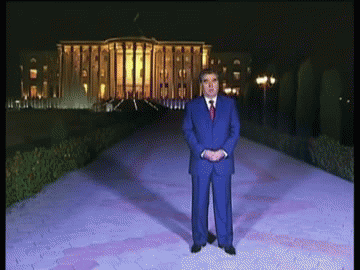
-
Controversial Rainbow Sculpture in Warsaw
- March 23, 2013 - 5:47 pm
- New monument, Poland
- Comments Off on Controversial Rainbow Sculpture in Warsaw
The New York Times reports on the controversy over a rainbow sculpture in central Warsaw seen as symbolic of gay and lesbian rights. See the link here for the full story and a top-notch photo of the half-burned sculpture.
March 21, 2013Rainbow Becomes a Prism to View Gay Rights
By HANNA KOZLOWSKA
WARSAW — The 30-foot-tall rainbow sculpture in downtown Savior Square here is looking somewhat the worse for wear these days, half covered in patches of artificial flowers and half bare from being set on fire. What was intended as a work of public art without an overt political message beyond the need for inclusiveness, according to the artist behind it, has instead become part of a culture war over homosexuality that has been brewing in one of Europe’s most Catholic countries.
Since its June installation in the square — a busy crossing place for trams that also has a famous church and a buzzing bar and cafe scene — the rainbow has been set on fire four times and come under attack from right-wing politicians and Web sites.
Stanislaw Pieta, a member of Parliament from the conservative Law and Justice Party, the main opposition faction in Poland, called the placement of the rainbow on a grassy circle in front of the church a “disgusting gesture, offensive to Catholics.” He added, “It’s a provocation.”
Although city officials and the artist, Julita Wojcik, say the rainbow is not a monument to gay rights, both its supporters and opponents find they can agree on what the rainbow symbolizes.
The debate over gay rights has gathered steam in Europe over the past year. France’s lower house passed a bill last month that will grant the right to marry to same-sex couples if the upper house approves it in April, as expected. Germany’s Federal Constitutional Court last month expanded adoption rights for gay couples.
Poland’s first openly gay and transgender members of Parliament were elected in 2011. But their reception, even from the most prominent members of society, has been anything but a universal embrace. Lech Walesa, the former president, revered anti-Communist opposition leader and Nobel Peace Prize winner, surprised many here when he declared that gay lawmakers should be sitting in the back rows of the Polish Parliament, “or even behind a wall.”
Dorota Chojna, 39, a volunteer who has helped repair the burned rainbow, said in a telephone interview that she felt uneasy. “As a homosexual person, I don’t feel safe in Warsaw,” she said. “I became involved in the rebuilding to oppose pervasive homophobia, among other reasons.”
Poland’s economy has thrived in recent years, avoiding the deep recessions that have plagued its neighbors in Eastern Europe as well as the stagnation that has set in among countries to the west. But like many societies in the former Soviet bloc, Poland is divided between those who have benefited from the dynamic economy and those who feel left behind by rapid change, social as well as economic.
The rainbow was not the first work of public art to receive criticism here in Poland’s capital. While the city has long featured statues of kings, saints and the beloved composer Chopin, a 50-foot artificial palm tree by the artist Joanna Rajkowska caused confusion and no small amount of consternation when it was erected in 2002. A work about the city’s lost Jewish population — referring to the warmer climate in Israel — the palm tree has slowly been accepted as part of the city’s skyline.
“If the city is to develop, it needs new symbols,” said Ms. Rajkowska, who supports the rainbow.
Known as Plac Zbawiciela in Polish, Savior Square takes its name from the 19th-century Church of the Holiest Savior, whose twin spires tower over it. But the square is also known as Plac Hipstera, or hipster square. While older residents in overcoats and berets go to Mass at the church, minor celebrities and affluent teenagers sip lattes, all within sight of the damaged arch.
The structure was first installed in front of the European Parliament in Brussels in September 2011, to honor Poland’s turn at the rotating presidency of the European Union. Ms. Wojcik, its creator, said in an interview at the Zacheta National Gallery of Art in Warsaw that the rainbow was intended as a symbol of tolerance.
“In 2011, Poland was seen as a homophobic country,” she said. “I wanted to show that we’re not closed, but open-minded.”
Ms. Wojcik brought the rainbow back to Poland last June, in time for the European soccer championships that Poland hosted with neighboring Ukraine. Then the trouble began.
Originally covered with some 16,000 artificial flowers, the rainbow quickly turned into a giant Rorschach test for residents. To some, the rainbow is just a rainbow. “I think about the happiness in life,” said Jadwiga Wilczynska, 78, smiling as she looked at the sculpture.
To Wlodzimierz Paszynski, the deputy mayor of Warsaw, “It’s a sign of unity; it evokes warm feelings.”
Ms. Wojcik, 42, said: “The rainbow is not a pro- or anti-gay declaration. It’s about tolerance, diversity, openness.” She said her goal was to strip the rainbow of all its political meaning, leaving the interpretation open and making it a bridge of mutual tolerance. She apparently did not succeed in that goal, since the one reading of the sculpture has overshadowed any others.
At least one of the four fires has been deemed an accident from New Year’s fireworks. In another fire, the perpetrator was inebriated and, according to the Warsaw police, he did not disclose his motives. The other two fires remain unsolved.
Some insist that there is no larger goal behind the attacks. “It’s just vandalism,” said Maria Klosinska, whose sister owns Charlotte, a bistro on the square.
But the critic Roman Pawlowski wrote on the Polish online news site gazeta.pl that calling the arson “vandalism” was a euphemism. “Actually, we’re dealing with an act of terror,” he wrote.
The Rev. Dariusz Kowalczyk, a Jesuit priest, reminded readers of the Roman Catholic weekly Idziemy that rainbows have other connotations. “When we see a rainbow in the sky, we shouldn’t think about gay activists, but about Noah’s covenant with God,” he wrote.
The rainbow was meant to be a temporary fixture, but city authorities agreed to push back the date of its dismantling several times, and in February they decided to leave it there for another year. At night it becomes a jungle gym for adults, many of whom have been enjoying time in a nearby bar, who climb on top and even crawl inside the steel frame.
For a planned refurbishing, the Adam Mickiewicz Institute, a publicly financed organization that sponsored the rainbow, is looking for flame-resistant materials. But some feel that for a city scarred by war and Communism, the tattered, slightly charred version of the rainbow is fitting.
“It’s a testimony of sorts,” said Marcin Malenczyk, the owner of Karma Coffee, one of the cafes on the square. “It’s good that it’s had its adventures.”
Nicholas Kulish contributed reporting from Berlin.


